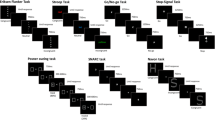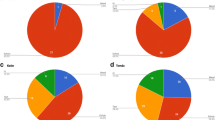Abstract
Diazepam (10 mg) was administered to two men performing a delayed matching-to-sample task in which the number of elements in a compound sample stimulus (one of which appeared among 4 comparison stimuli) was manipulated from 1 to 3. After each trial, subjects pressed either a “Yes” or “No” button in response to a computer-presented query about whether the last choice met a point contingency requiring selection of the matching comparison stimulus within a time limit. Diazepam simultaneously produced marginal decreases in matching-to-sample performance and more pronounced decreases in the accuracy of self-reports about the same performance. Diazepam selectively increased false reports of success; false reports of failure were not systematically affected. A signal-detection analysis summarized these patterns as a decrease in self-report discriminability (A′) with no systematic change in bias (B′H). These preliminary results converge with those of clinical lore and the results of studies with other benzodiazepine drugs in suggesting that diazepam can produce an “overconfidence” in performance self-evaluation, the mechanisms and parameters of which remain to be identified. The results were inconsistent with those of one previous study of diazepam’s effects on performance self-evaluation, but given procedural differences between the two studies, the discrepancy may reflect the functional independence of verbal operant classes in Skinner’s (1957) taxonomy.
Similar content being viewed by others
References
Baldessarini, R. J. (1990). Drugs and the treatment of psychiatric disorders. In A. G. Gilman, T. W. Rall, A. S. Nies, & P. Taylor (Eds.), The pharmacological basis of therapeutics (8th ed.) (pp. 383–435). New York: Pergammon.
Branch, M. N. (1984). Rate dependency, behavioral mechanisms, and behavioral pharmacology. Journal of the Experimental Analysis of Behavior, 42, 511–522.
Carver, C. S., & Scheier, M. F. (1981). Attention and self-regulation: A control-theory approach to human behavior. New York: Springer-Verlag.
Critchfield, T. S. (1993). Signal detection properties of verbal self-reports. Journal of the Experimental Analysis of Behavior, 60, 495–514.
Critchfield, T. S., & Perone, M. (1990). Verbal self-reports of delayed matching to sample by humans. Journal of the Experimental Analysis of Behavior, 53, 321–344.
Critchfield, T. S., & Perone, M. (1993). Verbal self-reports about matching-to-sample success: Effects of the number of elements in a compound sample stimulus. Journal of the Experimental Analysis of Behavior, 59, 193–214.
Critchfield, T. S., & Schlund, M. (1992, May). Do drugs really impair judgment? Drug effects on performace self-evaluation. Paper presented at the 18th Association for Behavior Analysis Convention, San Francisco, CA.
Curren, H. V. (1986). Tranquillising memories: A review of the effects of benzodiazepines on human memory. Biopsychology, 23, 179–213.
Dougherty, D. M., Nedelmann, M., & Alfred, M. (1993). An analysis and topical bibliography of the last ten years of human operant behavior: From minority to near majority (1982–1992). Psychological Record, 43, 501–530.
Evans, S. M., Critchfield, T. S., & Griffiths, R. R. (1992). Abuse liability assessment of anxiolytic/hypnotics: Rationale and laboratory lore. British Journal of Addiction, 86, 1625–1632.
Evans, S. M., Funderburke, F. R., & Griffiths, R. R. (1990). Zolpidem and triazolam in humans: Behavioral and subjective effects and abuse liability. Journal of Pharmacology and Experimental Therapeutics, 255, 1246–1255.
Green, D. M., & Swets, J. A. (1966). Signal detection theory and psychophysics. New York: Wiley.
Grier, J. B. (1971). Nonparametric indexes for sensitivity and bias: Computing formulas. Psychological Bulletin, 75, 424–429.
Griffiths, R. R., Stitzer, M., Corker, K., Bigelow, G., & Liebson, I. (1977). Drug-produced changes in human social behavior: Facilitation by d-amphetamine. Pharmacology Biochemistry & Behavior, 7, 365–372.
Higgins, S. T., Hughes, J. R., & Bickel, W. K. (1989). Effects of d-amphetamine in choice of social versus monetary reinforcement: A discrete-trial test. Pharmacology Biochemistry & Behavior, 34, 297–301.
Higgins, S. T., & Stitzer, M. L. (1988). Time allocation in a concurrent schedule of social interaction and monetary reinforcement: Effects of d-amphetamine. Pharmacology Biochemistry & Behavior, 31, 227–231.
Hindmarch, I., & Ott, H. (Eds.) (1988). Benzodiazepine receptor ligands, memory, and information processing. New York: Springer-Verlag.
Lubin, R. A. (1979). Influences on alcohol, interpersonal feedback, and drinking experience upon performance and judgment. Perceptual and Motor Skills, 48, 95–104.
Maylor, E. A., Rabbitt, P. M. A., & Connolly, S. A. V. (1989). Rate of processing and judgment of response speed: Comparing the effects of alcohol and practice. Perception & Psychophysics, 45, 431–438.
Morrow, D., Leirer, V., Yesavage, J., & Tinklenberg, J. (1991). Alcohol, age, and piloting: Judgment, mood, and actual performance. International Journal of the Addictions, 26, 669–683.
Oah, S., & Dickinson, A. M. (1989). A review of empirical studiesof verbal behavior. Analysis of Verbal Behavior, 7, 53–68.
Poling, A., & LaSage, M. (1992). Rule-governed behavior and behavioral pharmacology: A brief comment on an important topic. Analysis of Verbal Behavior, 10, 37–44.
Rabbitt, P. M. A. (1979). Current paradigms and models in human information processing. In V. H. Hamilton, & D. M. Warburton (Eds.), Human stress and cognition: An information processing approach (pp. 115–140). New York: Wiley.
Roache, J., & Griffiths, R. R. (1985). Comparison of triazolam and pentobarbital: Performance impairment, subjective effects and abuse liability. Journal of Pharmacology and Experimental Therapeutics, 234, 120–133.
Roache, J., & Griffiths, R. R. (1987a). Interactions of diazepam and caffeine: Behavioral and subjective dose effects in humans. Pharmacology, Biochemistry, & Behavior, 26, 801–812.
Roache, J., & Griffiths, R. R. (1987b). Lorazepam and meprobamate dose effects in humans: Behavioral effects and abuse liability. Journal of Pharmacology and Experimental Therapeutics, 243, 978–988.
Roy-Byrne, P. P., Uhde, T. W., Holcomb, H., Thompson, K., King, A. K., & Weingartner, H. (1987). Effects of diazepam on cognitive processes in normal subjects. Psychopharmacology, 91, 30–33.
Schutz, H. (1982) Benzodiazepines: A handbook. New York: Springer-Verlag.
Skinner, B. F. (1957). Verbal behavior. Englewood Cliffs, NJ: Prentice-Hall.
Skinner, B. F. (1989). The listener. In B. F. Skinner, Recent issues in the analysis of behavior (pp. 35–47). Columbus, OH: Merrill.
Stitzer. M. L., Griffiths, R. R., & Liebson, I. (1978). Effects of d-amphetamine on speaking in isolated humans. Pharmacology Biochemistry & Behavior, 9, 57–63.
Taylor, J. L., & Tinklenberg, J. R. (1987). Cognitive impairment and benzodiazepines. In H. Y. Meltzer (Ed.), Psychopharmacology: The third generation of progress (pp. 1449–1454). New York: Raven.
Vogel-Sprott, M. (1975). Self-evaluation of performance and the ability to discriminate blood alcohol concentrations. Journal of Studies on Alcohol, 36, 1–10.
Zettle, R. D., & Hayes, S. C. (1982). Rule-governed behavior: A potential theoretical framework for cognitive-behavior therapy. In P. C. Kendall (Ed.), Advances in cognitive-behavioral research and therapy (pp. 73–118). New York: Academic Press.
Author information
Authors and Affiliations
Additional information
This study was conducted while the author was a postdoctoral fellow under Grant 03389 from the National Institute on Drug Abuse to Roland R. Griffiths, whose support of the research is much appreciated. John Texter capably collected the data and helped prepare them for analysis. I thank Mark Sundberg and two anonymous reviewers for helpful comments.
Rights and permissions
About this article
Cite this article
Critchfield, T.S. Behavioral pharmacology and verbal behavior: Diazepam effects on verbal self-reports. Analysis Verbal Behav 11, 43–54 (1993). https://doi.org/10.1007/BF03392886
Published:
Issue Date:
DOI: https://doi.org/10.1007/BF03392886




